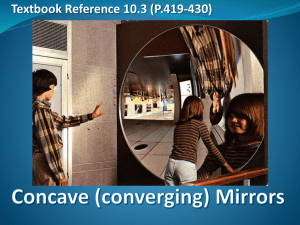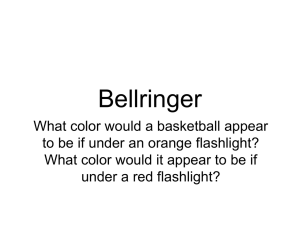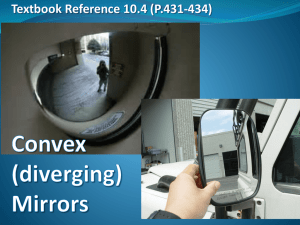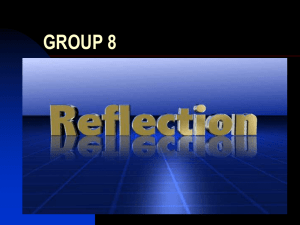Reflection In Curved Mirrors
advertisement
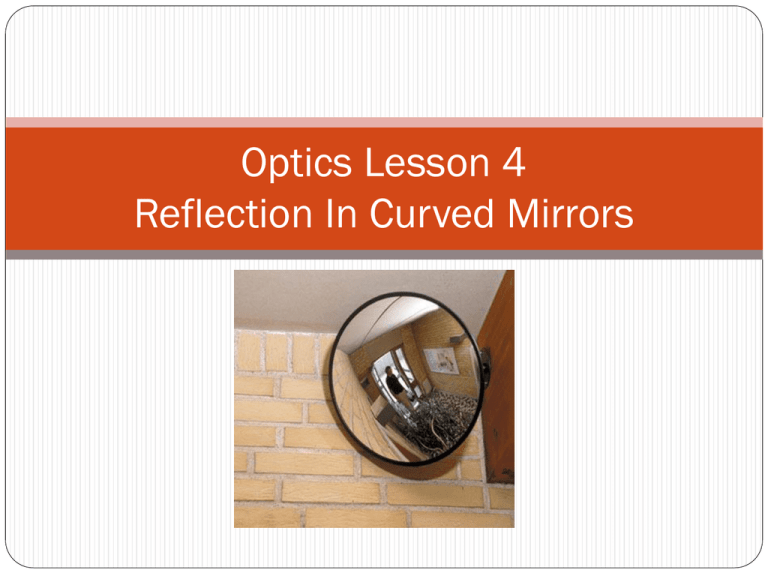
Optics Lesson 4 Reflection In Curved Mirrors Terminology Centre of curvature (C) – Middle of the “circle” Focus (focal point) (F) – Where reflected rays all intersect Principal Axis (PA) – The line drawn through the centre of the mirror (and meeting the mirror at 90°) Vertex (V) – The exact point where the PA meets the mirror. Recall Light rays always have an Angle of Reflection = Angle of Incidence This equal angle is between the ray and the normal with is a90° to the mirrors surface at the point where the ray hits the mirror Angle of Incidence Normal (90° to mirror surface) Angle of Reflection Terminology Concave Mirrors – are also known as converging mirrors as the light converges at the focus in front of the mirror and creates a real image. Mirror is “caved” in Convex Mirrors – are also known as diverging mirrors as the focus is found behind the mirror (virtual image) and is found by tracing back the reflected rays in a straight line. Focal Point – Concave Mirror We can use parallel rays to PA to find the focal length of a concave mirror. All parallel lines will reflect into the focal point *note the normal is 90° to the point on the mirror where the ray strikes The focal point for a concave mirror is to the left Concave Mirror Rules Concave Mirror Rules Concave Mirror Rules Concave Mirror Rules Ray Diagrams – Concave Mirrors You need 2 rays to locate an image. The image is located where the rays intersect. If the rays do not intersect, you need to trace them back to the point where they intersect. You need to include 2 basic rays. 1. A parallel ray is reflected to the mirror then through the “focal point” 2. A ray is sent through the focal point is reflected parallel to the principal axis. F Ray Diagrams Describing Images S – Size (Larger, Smaller, Same) A – Attitude (Upright or inverted) L – Location (How far from the mirror?) T –Type (Real or Virtual) Small than object Inverted Between C and F Real F Object beyond C Object at C Object between C and F Object at F Object between F and mirror Properties of a Converging Mirror p. 499 Uses of Concave Mirrors Searchlights, car headlights and flashlights all use concave mirrors to create parallel or almost parallel beams of light (Why?) Telescopes and satellite dishes use concaves mirrors to focus electromagnetic waves at the focal point (Why?) Uses of Concave Mirrors Con’t We can also use concave mirrors to magnify a reflection close up. Why does it give this type of reflection? End of Day 1 Optics Lesson 4 Reflection In Curved Mirrors Recall Light rays always have an Angle of Reflection = Angle of Incidence This equal angle is between the ray and the normal with is a90° to the mirrors surface at the point where the ray hits the mirror Angle of Incidence Normal (90° to mirror surface) Angle of Reflection Terminology Concave Mirrors – are also known as converging mirrors as the light converges at the focus in front of the mirror and creates a real image. Mirror is “caved” in Convex Mirrors – are also known as diverging mirrors as the focus is found behind the mirror (virtual image) and is found by tracing back the reflected rays in a straight line. Focal Point – Convex Mirror The focal point for a convex mirror is to the right. It can be found by drawing lines parallel to the PA towards the mirror Extend the reflected lines past the mirror Where the imaginary lines intercept is the focal point Centre of sphere – Convex Mirror The C for a convex mirror is to the right. It can be found by drawing a line perpendicular to the mirror at any point Extend the reflected lines past the mirror Where the imaginary lines intercept the PA is the C Convex Mirror Rules The difference between a concave mirror and a convex mirror is that in a convex mirror, F (now called a virtual focus) and C are behind the mirror and light rays seem to come from an apparent light source behind the mirror Convex Mirror Rules Convex Mirror Rules Convex Mirror Rules Ray Diagrams – Convex Mirrors The image is located where the extended reflected lines intersect behind the mirror You need to include 2 basic rays. 1. A parallel ray that extends from the top of the object to the mirror and is reflected back to the viewer 2. A ray is directed towards the focal point and is reflected parallel to the principal axis. 3. Extend the reflected rays past the mirror until they intersect 4. The point of intersection is the top of the image. The image extends down to the Principal axis Images in a Convex Mirror The rays reflected off a convex mirror always diverge Reflected rays from an object never cross in front of the mirror to form a real image Instead it ALWAYS creates a smaller, upright, virtual image Uses of Convex Mirrors Convex mirrors show a wide range of view with their smaller virtual image . Used in: Security mirrors Side-view mirrors in cars “Objects in mirror are closer than they appear” ?????? One More Demonstration Concave vs. Convex Curved Mirrors http://www.phy.ntnu.edu.tw/ntnujava/index.php?PHPSESSID=643ae5 051e223f1f696d419c040b986d&topic=48.msg297#msg297

